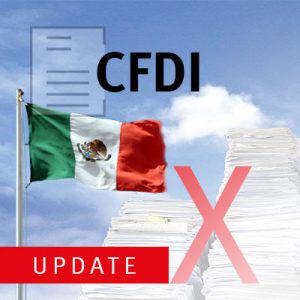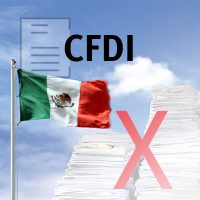CFDI-Invoices Version 3.3 in Mexico: Deadline extended

What are CFDI-Invoices?
In Mexico, since 2011 most electronic invoices (E-Invoicing) have to be created in CFDI format. CFDI stands for “Comprobante Fiscal Digital por Internet” – means a digital fiscal document via Internet (Invoice). The CFDI invoice must, on the one hand, include the signature of the exhibitor and on the other hand, the signature of a certification provider PAC “Proveed Autorizado de Certificación”. The PAC in turn must be authorized by the Mexican Federal Agency for tax affairs SAT.
CFDIs are available in four types: invoices, direct debits, credit memos and freight notes. For this purpose, the CFDI tipoDeComprobante attribute can have following values:
- “Ingreso for facture” (invoice) or “nota de cargo” (direct debit)
- “Egreso for nota de crédito” (credit note)
- “Traslado for carta de porte” (freight notes)
Which Deadlines are valid for the implementation of CFDI-Version 3.3?
Update: The Mexican tax authority gives a month extension for CFDI 3.3. From the 1st of January 2018, every CFDI Bill has to be published in the Version 3.3 and not as before at the 1st of December 2017.
About a week before the original deadline on the 1st of December should be taking effect, the Mexican tax authority SAT has published at the 22nd of November 2017 the new deadline for the mandatory usage of version CFDI 3.3. Also it´s possible to send invoices for one month longer based on the prior Version 3.2 of CFDI.
The Payment Complement (Complemento para Recepción de Pagos), which include information about received payments, is available in CFDI Version 3.3.
Update: The information about incoming payment has to be sent in the Payment Complement starting at the 31st of March 2018 to the Mexican tax authority. Before it´s optional but not required.
Update invoice reverse: The approval procedure for the cancelation of an electronic Invoice just takes effect at the 1st of July 2018.
From there on invoices can be canceled only in exceptions. Also cancellations typically need the authorization of the invoice recipient within a determined deadline.
Update penal deferment for certain mistakes: Up to the 30th of June 2018 certain mistakes like registration mistakes, divergent units etc. are not punished by the SAT.
You can check out the exact text of the time extensions on the homepage of the SAT https://www.gob.mx/sat/prensa/com2017_125 .
What does the new version 3.3 bring with CFDI invoices?
Since July 1, 2017 and from December 1, 2017, the CFDI invoices must be issued in the new version 3.3.
This is the most significant format adjustment since 2011, which includes improvements in the following areas:
- New Catalogs
- Time zones with references to the exhibition venue
- Transmitted and withheld tax according to the catalogs
- Changes in payment methods
- Currencies other than Mexican Pesos
On the SAT web page, you will find more details: http://www.sat.gob.mx
In addition to the electronic CFDI invoice to be signed, the invoice provider often needs a PDF visualization, which he also sends to his customers. This PDF visualization is in Mexico-like XML format – to a large extent firmly prescribed. In addition to certain accounting information, the PDF must contain a 2d barcode.
As one can already see from these legal requirements, the electronic invoicing process is strongly regulated and relatively complex due to multiple signing at various levels.
With SEEBURGER, the complex CFDI-process can be implemented quickly and easily
The CFDI-process can only be implemented with the help of external providers such as PAC. The complexity is comparable to the electronic invoicing procedures in other countries of South America or, for example, those in Turkey or Portugal. In order to simplify the implementation and to minimize the risks, it is recommended to work with a partner who knows the requirements in Mexico and other countries. The benefits are obvious: An experienced partner can assist you with the introduction competently, can bundle your increasing international E-invoicing-requirements and thus ensures unification and standardization. A start is also recommended by booking a cloud service.
For E-invoicing requirements are often not only technically complex, but cause high initial costs in its own operation. This is matched by an immediately usable, preconfigured cloud service, to which the invoice data is to be transferred only in a clearly defined interface format.
With SEEBURGER Cloud Services for E-invoicing in Mexico – and many other countries – SEEBURGER offers you a secure, comfortable, scalable and high-performance entry at full cost transparency. We create the CFDI in the current version 3.3, let it sign, visualize it for you and transfer these invoices to your customers. These cloud services are independent of the ERP system and can be expanded to include legally compliant archiving.
Learn more about SEEBURGER Cloud Services for E-Invoicing
Thank you for your message
We appreciate your interest in SEEBURGER
Get in contact with us:
Please enter details about your project in the message section so we can direct your inquiry to the right consultant.
Written by: Gerrit Onken
Gerrit Onken has been at SEEBURGER since 2010 as a product manager for software applications and for electronic data exchange services for the business sector. He focuses on solutions for SAP, electronic invoicing (e-invoicing) and innovations for digitalizing business and technical processes for globally-active customers. Originally a banker, Gerrit Onken went on to graduate in business administration, majoring in industrial management and business informatics. After working in the financial sector, he worked as a manager and project manager from 2004 to 2010 for one of the top five corporate consultancies, working with international BPOs in the banking and automotive industries.





